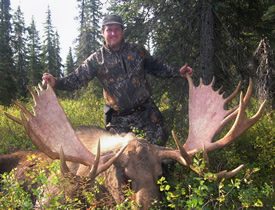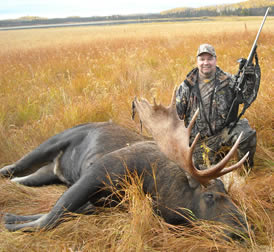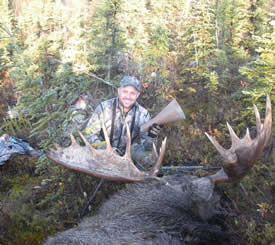by Wayne Kubat
I’m an Alaskan Master Guide-Outfitter and with my wife Marilyn, have owned and operated our own business Alaska Remote Guide Service since 1986. I have participated in scores of successful moose hunts both unguided and guided since moving to Alaska in 1976. In addition to guiding, we market two video guides on moose calling and hunting Love, Thunder & Bull in Alaska, volumes 1 & 2 which I produced myself. We also make and market the Bull Magnet™, a durable fiber glass megaphone that serves 5 useful functions for calling moose. Thousands of these are currently in use in Alaska and elsewhere. On our website, we have video clips that you can view from both of our DVDS along with numerous product testimonials for our calls and DVDS from all over the world. I hope you will check them out!!

Hi Wayne, Attached are a couple of photos of the 68″ Moose I shot this September in the Wood TikChik area using the Bull Magnet on a DIY hunt. Your videos were very helpful & provided a wealth of information. Thanks again for putting together a great product. Matt Tobler
I get pretty serious about moose hunting, and don’t much like an empty freezer. For about 15 years now, I’ve used a pretty consistent strategy that seldom lets me down. This strategy is geared towards hunting bulls but can certainly bring in cows as well. I’ve found this strategy to be very effective from late August, when bulls first start scraping the velvet off their antlers, through the rut in late September and beyond. My strategy is this: Once I decide where I’m going to hunt, I commit myself to that spot for at least 3 days rain or shine. I use various moose calls and sounds to make bulls come to me, rather than tromp around the country side and chase everything off. You’ll have plenty of opportunity for exercise once you get a bull down!
Moose have incredibly good hearing along with the ability to pin point the exact location of any sound. Many times I’ve had bulls come to within inches of my last calling location several hours after I left, and sometimes as long as a day or two later. This article deals with hunting strategy more so than deciding where to hunt, but I will touch on a few basics that I look for in site selection when my winter’s supply of meat and several days of my time are on the line.
Selecting a hunting area
I tend to favor areas above timberline that over look swamps and mixed areas of birch and willow. Natural drainages with ponds and/or beaver dams are especially good because moose like water and feed on pond weeds and grasses. However, moose habitat varies greatly, and I’ll consider any spot with decent visibility and lots of moose sign. I want to see plenty of evidence in the form of fresh tracks, droppings, beds, rubs, scrapes, scent pits, etc. The presence of major game trails and old scrapes and rubs from previous years will prove further that you are in a good area.
Admittedly, it is getting harder and more expensive to do every year – but I like to get as far off the beaten path and away from crowds, ATV activity, boat traffic, and airplane noise as I can. It’s really a bummer to have the granddaddy of all bulls coming in to your call, only to have him get run off by one of the above. Not only that, but moose tend to get really nocturnal in areas with lots of hunting pressure and noise, and will wait until well after dark to investigate your calling efforts.
When choosing a hunting area, I’m also looking for one that offers good places to glass and call from. Selecting a good glassing area or lookout is especially crucial, because this is where I and/or my partner will spend 90 % of every day light minute over the next 3 days or until we get our bull.

I purchased your videos and call in 2008 in preparation for a do it yourself moose hunt that fall. I am lucky enough to have a hunting buddy whose cousin lives in Alaska and has his own float plane. We had him drop us off and used your strategies and call techniques to success and killed him on the last day of the hunt. I will recommend others to do so as well, or use your services if they are looking for a guided hunt. Randy Schuster
I’ve used tree stands, hills, ridge lines and small thickets of brush bordering large swamps. Whatever the case, I’m looking for a location that gives me the best possible view of the surrounding area. When ever possible, I also like to be able to set up camp close to my glassing location. First and last light are prime hunting times and I don’t like to waste prime time traveling great distances to and from camp.
Once I’ve chosen my glassing location, I try to select two or three calling locations close to some of the moose sign that I mentioned above, that are about 100 to 200 yards distant from my glassing location. I like to have multiple calling locations so that if the wind direction is wrong for one spot, I have other options. Large bulls have exceptional hearing because their antler mass draws in sound, much the same way as cupping your hand to your ear does. Calling from multiple locations will also sound like multiple animals and more activity, and is likely to increase the interest level of a distant bull.
Hunting strategy
I like to have my camp set up and my glassing and calling locations picked out by no later than 4:00 PM on the first day and 2:00 PM is better. Although not much is likely to happen until evening, I like to make my first calling sequence by mid afternoon because I want to be first on the list of party spots that a listening bull visits. If my brush thrashing gets his attention first, he’s liable to check me out first – especially if I keep reminding him every so often through out the afternoon. I stick with
this strategy even when hunting from fly out camps where you can’t legally hunt until the next day. Though you might have a bull come in before you can legally shoot him, often he will hang close by and can be called in again the next day. And having a live bull in the area will greatly enhance the credibility and effectiveness of your own calling efforts, as well as boost your confidence.
I always start out in my glassing location first and look over the area thoroughly. If I don’t see anything, I’ll proceed to one of my calling locations and “brush thrash” for 20 to 30 minutes and then return to my lookout. If I have a partner, one of us will stay in the lookout. The other hunter may be able to see a bull responding to your calls that you can’t. I prefer to return to my lookout after each calling session, because extended glassing requires stretching, moving around to keep warm and occasional nature calls. These activities make noise and saturate an area with scent.
I’ll repeat this routine every 2 to 3 hours, except that I usually do my last three sessions of the day at one-hour intervals. I usually end my last session 30 to 45 minutes before dark and will remain in my lookout until I can no longer see good enough to shoot. I’ll return to my lookout at day break and do my first calling session just as soon as it is light enough to make sure a bull hasn’t come in overnight. I’ll usually do my second routine of the morning an hour later and then return to 2 to 3 hour intervals until evening.
I’ll continue this strategy for at least 3 days or until I get my bull. If there are legal bulls within 2 to 3 miles, and sometimes even further when the wind is right, 3 days is almost always enough time to bring them in. We’ve killed many bulls on the first day, but sometimes an extra day might be necessary if it is early in the season or you get a really bad stretch of weather – whether too hot or wet and windy.
Brush thrashing

Wayne, I just wanted to send you a picture from my 4th day ever hunting moose, on drop camp hunt. Using your call I was able to call this bull in by myself on 9/14, using brush thrashing, bull grunts and a few cow calls. Thanks for a good product that works. Gene Fleming
I primarily use only brush thrashing in most calling sessions through about the first week of September. The exceptions to this are that I’ll use one or two long, loud cow calls at the start of my first calling session in the morning and at the end of my last calling session at night. I also like to use a few one to two hours before day break. Cow calls can carry a long way, especially when amplified through a good megaphone. I’m hoping to tweak the curiosity of distant bulls that are beyond brush thrashing range.
Brush thrashing sounds can be made several different ways. The loud cracking sound of breaking branches off a dead spruce tree can also be heard by a bull at great distances. So can the sounds of beating that branch against the trunk and raking brush with it. Ax handles, and scapulas also work well, as does our Bull Magnet™. The goal is to sound like bulls trying to scrape off their velvet or fighting. I try to start really loud for the first few minutes to get the sound out there and get their attention, and then tone it down. I thrash for two to three minutes, then pause for two to three minutes, and repeat this sequence throughout my 20 to 30 minute calling sessions.
Don’t under estimate brush thrashing sounds!
Once I flew a hunter into camp on August 28th in anticipation of the September 1st opening. On the way in, we flew over a 65 inch bull 3 or 4 miles up river from camp and on the opposite side. He was beating the heck out of a bush and scraping off the remains of his velvet. Because it was early in the season, we didn’t expect him to move much and planned to go after him on opening day. We used a double bladed ax to cut fire wood that afternoon from an old burn area 200 yards from our camp. The bull showed up in the exact spot we had cut fire wood in at last light that same day! I also witnessed an instance during mid day in early September, where a guy dropped a bull 15 feet from his cabin that came into the sounds of nailing the hinges back on to his door after it blew off in a storm. I can tell numerous stories that are similar, of big bulls coming into only brush thrashing sounds from late August on.
Bull Grunts and Cow Calls
Bulls generally make short deep grunts of one to two seconds in length in 2 to 3 second intervals when challenging each other to prove dominance or while moving around in groups to win cows. Bull grunts can vary a bunch, but I usually have pretty good luck with a short “U” or “Ugh!!” sound. I like to make them low pitched and a bit explosive sounding. An “OH!!” sound works pretty good too.
Cow calls can vary in length from 3 to 4 seconds up to almost a minute and are usually higher in pitch or tone than bull grunts. I use an “err” or “urr” sound. Start off low and carry the “r” to whatever length you want the call to be. I like to waver the tone on my longer calls by gradually raising the pitch in the middle of the call and then lowering it again while tapering the call off at the end.
By the second week of September — depending somewhat on weather and location — moose in many areas are just barely starting to move around and congregate in anticipation of the rut. I’ll start adding bull grunts and cow calls to the first and last calling sessions of each day. By mid September, I’ll usually include bull grunts and cow calls with the first and last two sessions of each day. My goal is to sound like a group of moose, both bulls and cows, and I often move around inside a 30 to 40 foot area when making the different sounds. And sometimes I will mix just a few bull grunts in with a mid day thrashing session to imitate a bull that is irritated and looking for trouble.
An early morning or late evening calling session in mid to late September might go something like this: I’ll start out with one or two long cow calls, then move 20 to 30 feet and thrash brush for a minute or so. Then I’ll make a few bull grunts to imitate a challenging bull or one that’s trying to gain the attention of a cow. I’ll continue to make bull grunts while moving slowly, often with a pause or two, towards the spot I made the cow calls from. When I get there, I’ll pause for a minute or so, and then will thrash some more brush and follow it up with a few bull grunts and sometimes a few short cow calls.
This whole routine may take 4 to 5 minutes. Then I’ll wait a few minutes and start the same or a similar sequence over again 20 to 30 feet in a different direction from where I made my last sounds. I move around because cows in heat and challenging bulls move around – they don’t stay in one spot. I’ll usually repeat this routine 3 to 4 times during a 20 to 30 minute calling session, and then will return to my look out.
During all of my pauses I am listening closely and glassing thoroughly for any response. And a word of caution – despite being so large, big bulls can really sneak in pretty quietly some times. Also, you could have a bear come in to your call expecting lunch. Stay alert and don’t let your guard down!!
The above strategy has worked really well for me time and again, but I know that many hunters just don’t have the patience to sit still and glass for several days – and some may not be able to get that much time off from work. Give it as much time as you can, and don’t get lax during mid day! Moose are most active early and late in the day but almost always they will get up about mid day to move around and feed a bit. Often bulls are bedded down before you make your first calls in the morning and this mid day stretch is when they will come to investigate your calling efforts. By keeping our look out manned constantly, we harvest almost half of all our bulls during mid day and often right at noon. Butchering a moose during daylight is so much nicer than having to do it in the pitch-black dark!!
Moose populations in many parts of Alaska receive heavy predation. Harvest a predator or two while you are at it and stay safe! Good luck hunting!